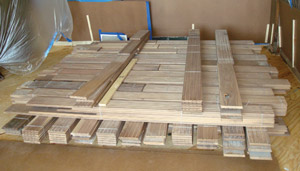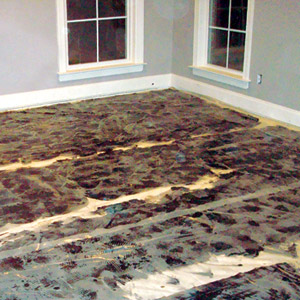 compromising substrate; qualified and experienced installation experts; protection of the material after the installation, and care of the flooring from the onset of use.
compromising substrate; qualified and experienced installation experts; protection of the material after the installation, and care of the flooring from the onset of use.
These six factors are essential for a successful floor covering installation regardless of the material.
When making sure the right product gets installed in the right space, or determining whether or not the material sold, selected or specified actually fits the function, we have to further ask the following questions:
- What’s the right flooring to use here and why?
- Will it live up to the end users expectations?
- Can it be installed without problems?
- Will it prematurely “Ugly Out”?
- Will it be reasonable to maintain?
- Will it last as long as they want it to?
This can be referred to as “qualifying the end use and end user.” It’s at this point most mistakes are made, since the biggest problem in the industry is the wrong product being installed in the wrong place and destined to disappoint. This can be as simple as selecting a different shade of colors in the flooring material chosen or using carpet instead of a hard surface flooring material or vice versa.
When we are consulting on large commercial installations, we will very often suggest products after qualifying the client and application of the flooring material and then conduct the testing on the flooring materials to determine which one will actually work or if we can make it fail. This preventive measure will eliminate a client from getting stuck with a product that won’t live up to their expectations.
The “appropriate environment controlled” means making sure the environment the flooring material is being installed in is controlled before, during and after the installation. All flooring must be installed into a space that, in simplest terms, is comfortable for human occupants. That is, the HVAC system is operating as it would while the space is occupied by people.
Most commercial spaces cycle the air handling system; they lower the temperature at night and on weekends. This cycling will not only raise and lower the temperature in the space, it also affects humidity levels. Gain and loss of humidity in a space will cause flooring material to expand or contract, gain or lose moisture, or cause moisture to move in and out of the concrete substrate.
All of these changes can wreak havoc with the flooring installation and the flooring material. People often shake their heads at the explanation of such physical changes, but you have to keep in mind that for every action there is an equal and opposite reaction; this is science and nature at work. With changes in heat and humidity in a space, it follows that there will be a reaction of the flooring material and installation to those changes. This is also an extremely important – though rarely considered – act to keep in mind when a flooring failure occurs.
A non-compromising substrate is a substrate, be it concrete or wood, that by the very nature of its physical or chemical makeup will either cause a flooring installation failure to occur or not. It should be common knowledge by now that alkalinity, moisture, porosity and topically or added chemical agents in concrete or highly burnished surfaces can and will cause an installation failure.
Most people don’t consider that plywood, particle board, OSB or Luan can also cause flooring installation failures. Wood subfloor material has chemicals in it that can and will cause adhesives to breakdown and fail. These subfloors can also have treatments, such as flame retardants, pest sprays, binding agents, phenolics and sometime even solvents in them that can and will cause installation failures.
It is important to always test the concrete, correctly, using an individual who is an ICRI-certified tester, and then properly treat the concrete substrate with a method that actually works. For wood, something as simple as a rolled on application of latex milk will often correct any compromising conditions.
For any flooring installation project, especially a commercial installation, it is imperative that the installers have the experience and knowledge to work with and properly install the flooring material selected. With a commercial installation, we always specify the installation firm have at least 10 years of experience, as well as the job super and the installers.
For specialty products such as woven Axminster or Wilton carpet, only installers and installation firms who specialize in this type of product should be employed. The same would be true of intricate installations of luxury vinyl tile or water jet-cut marble or stone flooring. Anyone who takes the chance of using the least expensive and least skilled installers on an expensive flooring project gets what they deserve and has no right to complain when the installation gets messed up.
 Once the flooring material is installed, it must be protected from damage by staying off of it for the appropriate time so adhesives can dry, and from damage during occupant move-in. This is especially true of commercial installations, where the flooring must be covered with Velcro carpet protector, Kraft paper, plywood or Masonite.
Once the flooring material is installed, it must be protected from damage by staying off of it for the appropriate time so adhesives can dry, and from damage during occupant move-in. This is especially true of commercial installations, where the flooring must be covered with Velcro carpet protector, Kraft paper, plywood or Masonite.
For double stick installations where the cushion is glued to the substrate and the carpet glued to the cushion, traffic should remain off the carpet for at least 24 hours. For stretch-in installations there is no concern for compromising adhesive, since none is used, but the product must be protected.
Furnishings should never be dragged over new flooring, and the flooring should never be a “drop cloth” for other trades working at the site.
Maintaining the flooring once it is installed is essential, though often not taken as seriously as it should. This can be compared to buying a new car and never washing it, changing the oil, rotating and balancing the tires or checking the brakes. Properly cared for, new flooring will last far beyond its life expectancy. Playing catch up after the flooring “uglies out” is near impossible to do. At this point people often want to blame the flooring material, but it can’t take care of itself; someone has to do that for it.
All of the points covered here are crucial to flooring success; they should be included in every flooring project, residential and particularly commercial. Not heeding these steps will increase the chances of a flooring failure.

Report Abusive Comment